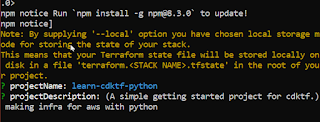Follow along with more DevOps stuff!
It's not only CloudFormation and YAML we can use to build infrastructure in AWS - The ever-popular Python is here.
I like how the docs say it should take around 6 minutes, and I'm here on maybe...minute 34 waiting for packages to finish installing. I'm sure it doesn't account for setup, but for a while, I was concerned I had misconfigured something.
No, there are just a ton of packages to download.
Node.js had to not only open Powershell, but update my chocolatey and some VS Code components.
Importing Python packages happens in consoles/terminals. You have to import them each session.
So, I open a terminal in VS Code to install this Pipenv Virtual Environment Package in theory. The hardest part is always installing Python packages, as I never remember what command works in Windows Terminal.
It's never pip install or apt-get, but 'python -m pip install [package], when you are not in the Python prompt.
Now, into the cmd prompt (not Admin), everything seems okay
Adding AWS as a Terraform provider tripped me up just a touch; Had to be careful and put the additional segment into the file. JSON is a lot less touchy in VS Code than it was in CloudFormation.
Then, it began to download and generate providers...and modules, something I recently learned about.
It takes a really long time.
Waiting is half the battle with this project, I see.
But I'll take it, because it's going well.
Explicitly importing classes in Python makes sense; If you aren't using it, don't have it where it can interfere with your project. My trouble with importing is similar to installing packages - The commands - and their use (Within a Python shell, cmd) - varies.
I'm sure with Python, using it in cmd out of context would be silly, but opening a Python shell alone often doesn't work. So I pull up VS Code and open a terminal.
The cmd output does say 'hello-terraform' is initialized and planned; That's not in the code, so I'm guessing it's in one of these Terraform packages.
Whoo hoo!
In doing all of that, I overlooked the region selection in the MyStack > def > AwsProvider header. So it showed up in the West.
The Instance (named hello in its Python context, but not in the AWS EC2 Manager) is successfully created in the California region.
The AMI is not the same as the sample code, but the IP address is.
Everything takes longer than using Terraform. Synthesizing? 3 minutes. Is that when you're supposed to go to the watercooler or whatever people who want us back in offices claim?
Actually renaming the instance took seconds. So the watercooler will have to wait.
Is it Reconnecting with the AWS servers about my particular setup? It's a possibility.
But we're not done yet, as I want to get a greater understanding of the code (hint hint, employers, that's called 'Self Study').
The entire code is, again, here.
I want to focus on 4 things; def, __init__, self, tags
def is a function, and __init__ initializes it to itself (with self?). self is part of a naming convention (like how people use foo and bar). Things after 'self' in the argument brackets are optional. This helped me understand.
Tags:
Here, it's how instances get their names. In Terraform, it's for organization.





Comments
Post a Comment